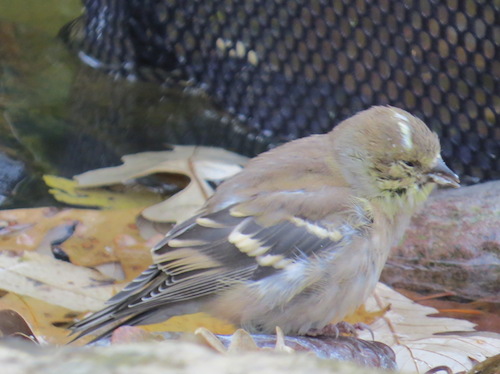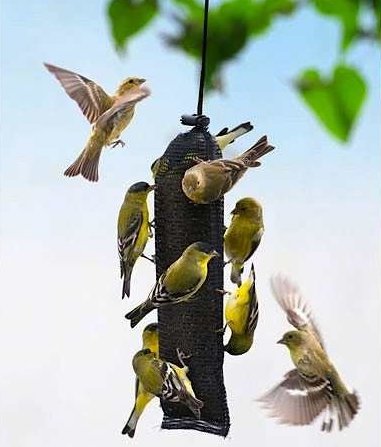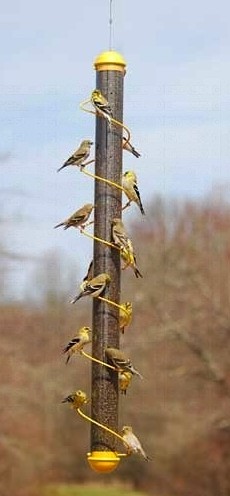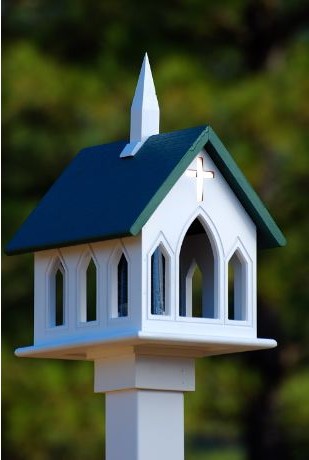-
Finch Bird Feeder Disaster
Without fail buds are blooming and bulbs spring forth from the ground… in February. Likewise without fail, the Atlanta area will experience another cold snap, snow or an ice storm before spring decides she’s here for the duration. The rain’s been fairly continuous for about three weeks, yesterday was a balmy 80 degrees!
Warm, wet weather spells disaster for bird feeders, especially finch bird feeders. It’s not that humidity affects thistle seed any differently from other seed mixes- it’s the unnatural and exaggerated number of birds feeding from the finch feeders.
Local populations of goldfinches, pine siskins and house finches are huge around this time of year. Combined with wet or moldy seed means disease can be spread rapidly, with the feeder itself or ground waste below as the main culprit.
Mold creates airborne disease which is usually fatal to birds. A form of strep, the most common way it’s passed is via the feeder. Telltale signs of infected birds are swollen eyes, lethargy (they allow you to get very close) and ruffled or unkept feathers.
The infected finch below will likely fall prey to predators or starve to death as total blindness sets in. It’s the best excuse for keeping bird feeders clean and the area below them raked free of hulls or waste. We attract birds to our gardens simply because we enjoy their beauty, song and grace… sick birds are anything but 🙁
It’s advised to take all bird feeders down and disinfect with a 10% bleach solution. Clean the ground below feeders well. Wait 2 to 3 weeks until the local thistle-eating population has subsided before hanging feeders again. This is a tough chore, both physically (and mentally for some of us bird nuts). So it’s best to avoid and practice good hygiene when enticing birds to your place! Humans do feathered friends no favors at all by causing disease or allowing it to spread.
-
Black Friday Offer: Free Thistle Feeder with Every Purchase
Black is the New Black:
Nab a Free Thistle Sock with Your Order Today!Because the American Goldfinch resides across most of the US, these fun little thistle feeders are likely useful in your locale.
Get one FREE with your purchase… and cross off a stocking-stuffer on that list! It’s an excellent way to introduce someone to backyard bird watching without going all-out!
Among some of the sweetest songbirds, goldfinches would rather take flight than vie for a spot at the thistle feeder. With their late breeding season, June through September sees the most activity. After that, a second molt brings new olive drab feathers for winter.
Breeding plumage occurs in late spring when the most vibrant yellow feathers appears. Parents feed thistle almost exclusively to babies so feeders do tend to get crowded.
They don’t use birdhouses, instead nesting in hedges or trees with nests constructed of woven plant fibers lined with thistle (from the weed) or milkweed down.
Another fun feeder which doesn’t require much space at all and accommodates 18 birds at once is the Rainbow Finch Feeder. Tall and slim, when all perches are occupied it’s quite the captivating site! Any birding enthusiast would be elated with this cool bird feeder. It’s easy to fill and clean and fairly obvious birds love them. Best of all… it’s on sale!Offering thistle (or nyjer) has many benefits:
• Squirrels usually leave these feeders in peace!
• Thistle won’t germinate causing weeds
• Other birds in the finch family may frequent the feeders such as indigo buntings, red polls, pine siskins and more.Yes, the sweet canary-like birds even earned the name “Charm” when referring to a large group! Lovely song and non-aggressive… why wouldn’t you entice them to your place?
Offer good through Monday, 11/28/16 and should cover Black Friday, Shop Small Saturday, Cyber Monday and any other big shopping days!
Get someone hooked on birds and get your free thistle sock today!
Wishing the happiest of holidays to you and yours!
-
When Choosing Bird Gifts- Think Thistle Feeders
Get a jump & don’t be stumped for gift ideas on the looming list!
It was easier and more fun when you could just write a letter to Santa, he rarely made mistakes. Well, except maybe for that time he arrived with a talking calendar… not so sure what happened that year 🙁Consider nature! A fab offering that shortens the distance between feathered friends and humans can be one that’s used everyday and for many seasons to come! A tube feeder filled with sunflower chips attracts chickadees, titmice and finches. A platform feeder covered with mixed seed like peanuts, black oil sunflower and millet entices cardinals, jays and sparrows, while thistle feeders keep American goldfinches fat and happy. Finches happen to be resident birds in most parts of the country, unlike migratory birds who, well- migrate south for the winter.
If you offer thistle (also known as nyjer seed) year-round, goldfinches’ vibrant yellow color will grace the yard in spring and summer. Duller, drab feathers in fall won’t deter them from feeders… it’s just the opposite! Thistle doesn’t germinate either, so no worries of weeds popping up below the feeder. The tiny black hulls can still pile up, but easy enough to scoop up every few weeks.
There’s some great feeders out there and a lot of bad ones too. It’s easy to be drawn to the artsy fartsey ones. You may think a good rule of thumb is the uglier the better… not so! One shaped like a church or big porch swing is all about lasting for years, and our own experience is that the best feeders are made right here in the USA. No problem with imported products, but unlike gadgets and electronics, the best bird feeders are still made here.
They should be easy to fill, but it’s more important that it be easy to clean. A good feeder is made to come apart so you can remove old or moldy food. Many folks buy large capacity feeders so they don’t have to fill them as often. That can be a mistake sometimes as rainy weather spoils seed before consumption. Several small feeders may be a better choice than one that is extra-large, unless of course you’re talking about The All-Weather Feeder, it laughs at driving rain and snow!
Wood bird feeders appeal to many people, and if cared for properly they will last. However, wooden feeders often fall prey to squirrels and get chewed up good! If you do happen to purchase any type of wood feeder, best to protect it… with sealant first and a squirrel baffle second.
If you’re thinking about giving anyone on your Christmas list only one feeder, a thistle feeder is tops, or you could always opt for the talking calendar!

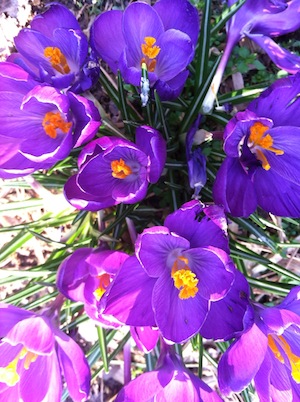 Without fail buds are blooming and bulbs spring forth from the ground… in February. Likewise without fail, the Atlanta area will experience another cold snap, snow or an ice storm before spring decides she’s here for the duration. The rain’s been fairly continuous for about three weeks, yesterday was a balmy 80 degrees!
Without fail buds are blooming and bulbs spring forth from the ground… in February. Likewise without fail, the Atlanta area will experience another cold snap, snow or an ice storm before spring decides she’s here for the duration. The rain’s been fairly continuous for about three weeks, yesterday was a balmy 80 degrees!
